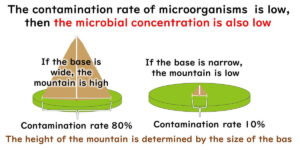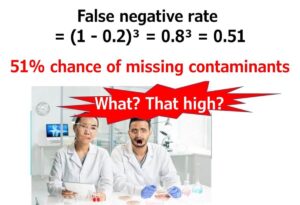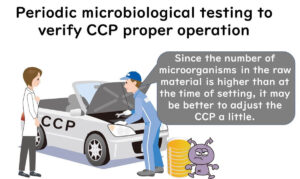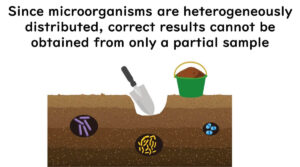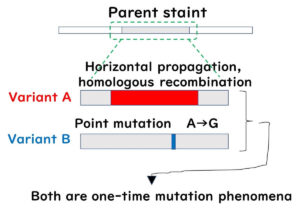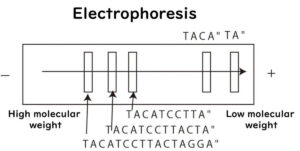Easy-to-Understand Food Microbiology Testing Sampling Plans in the ICMSF
The meaning of a "negative" result in food microbiological testing varies depending on the sampling plan used. This article aims to explain the sampling plans of the International Commission on Microbiological Specifications for Foods (ICMSF) in an accessible manner. These sampling plans are adopted in the EU's food safety and process hygiene standards. Understanding the rationale behind these sampling plans is more important than memorising the plans themselves. This article focuses on explaining the "why" for beginners.
Understanding the Accuracy of Microbial Testing of Food
To ensure food safety, it's essential to grasp the purpose of microbial testing and understand its accuracy. How likely are we to correctly detect contaminated food through microbial testing? For example, what is the probability of a false negative result when testing food samples with a 10% contamination rate if we test three samples? Alternatively, how many samples need to be tested to achieve 95% accuracy in detecting contamination in food samples with a 10% contamination rate? This article will guide you through these calculations step-by-step, using Excel for ease of understanding and application.
The Role of Microbial Testing in HACCP
While HACCP aims to reduce reliance on end-product testing, microbial testing still plays a vital role in effective hygiene management. This article explains when microbial testing is still necessary, how it supports HACCP implementation, and why it should not be entirely replaced by monitoring alone—even in highly controlled environments.
Flour-based cookie dough as a route of transmission of enterohemorrhagic Escherichia coli O157 infection.
Aside from food sources such as beef, the main infection routes for Enterohemorrhagic Escherichia coli (EHEC) O157 include contamination through livestock faeces, affecting soil in fields and environmental water, leading to tainted vegetables. However, there have been cases where seemingly unrelated foods have caused infections. An example from the US in 2009 involves a food poisoning incident from commercially packaged cookie dough made from wheat flour. This article introduces the paper by Dr. Neil and colleagues from the FDA, which summarises this incident.
How HACCP Reduces Reliance on Microbial Testing Through Process Control
HACCP (Hazard Analysis Critical Control Point) is a system designed to ensure food safety by preventing hazards before they occur, rather than relying solely on final product testing. This approach shifts the focus from microbial testing to process control, where risks are managed proactively at key points in food production.
But how does this system reduce the need for microbial testing? This article explores the fundamental concepts behind HACCP and how it has changed food safety management.
Unlocking the Potential of 16SrRNA Amplicon Sequencing in the Food Industry: Is It Truly Metagenomics?
Metagenomic analysis is a powerful tool in microbiology, allowing researchers to examine the entire genetic composition of microbial communities without the need for culturing. However, not all methods traditionally referred to as metagenomics, such as 16SrRNA amplicon sequencing, strictly fit this definition. Unlike full metagenomic approaches, 16SrRNA amplicon sequencing targets a single gene, offering a highly efficient method for microbial community analysis, particularly in the food industry.
This article explores how 16SrRNA amplicon sequencing improves food quality testing and helps resolve microbial contamination complaints. Additionally, we discuss its potential for routine microbial monitoring and zone management in food factories. Discover how this sequencing technique is shaping modern food safety practices.
Whole Genome Sequencing (WGS) in Molecular Epidemiology: SNP vs. Gene-by-Gene Analysis
Whole Genome Sequencing (WGS) has revolutionized bacterial strain typing in molecular epidemiology. In silico MLST, SNP analysis, and gene-by-gene analysis have emerged as key methods. This article explores how WGS-based approaches, including core genome MLST (cgMLST), are replacing traditional molecular typing techniques like PFGE and MLVA in public health and food safety.
Bacterial Strain Typing: PFGE, MLST, and MLVA in Molecular Epidemiology
Understanding how foodborne bacteria spread requires precise bacterial strain typing methods. Before the emergence of whole-genome sequencing (WGS), molecular epidemiology relied on classical typing techniques to track pathogen transmission and investigate foodborne outbreaks. Among these, Pulsed-Field Gel Electrophoresis (PFGE), Multi-Locus Sequence Typing (MLST), and Multiple-Locus Variable-number Tandem Repeat Analysis (MLVA) played a crucial role in identifying bacterial strains and understanding their genetic relationships.
This article provides an in-depth look at these traditional molecular epidemiology methods, explaining how they have been used in food safety and outbreak investigations.
DNA Sequencing in Food Microbiology: Principles and Applications
To understand DNA sequencing in food microbiology, it is essential to grasp how different types of DNA sequencers function. This article provides a clear overview of key sequencing methods, including the Sanger method (electrophoresis, capillary sequencer), next-generation sequencing (NGS) (Illumina, Ion Torrent), and third-generation sequencing (TGS) (nanopore sequencing).Designed for beginners in food microbiology, this guide explains these technologies in a visual and accessible way, with video demonstrations for clarity. We will also explore the practical applications of DNA sequencing in food safety and microbiological testing.
Ensuring Accuracy in PCR Food Testing: Avoiding False Positives and Negatives
Achieving accuracy in PCR food testing is critical for reliable microbial detection. This page explores common pitfalls that can lead to false positives and negatives, such as contamination, PCR inhibitors, and the lack of proper validation. By understanding these challenges and implementing effective precautions, food safety professionals can ensure dependable results and uphold the highest standards in quality control.Factors Inhibiting Gene Amplification (False Negatives)
